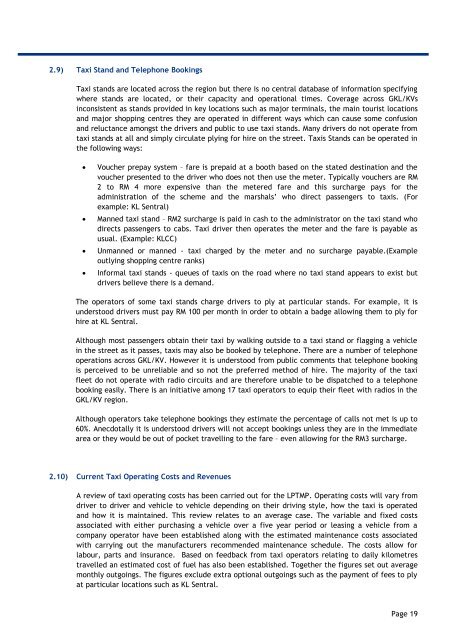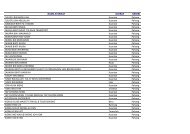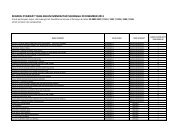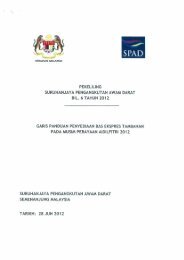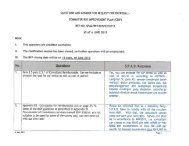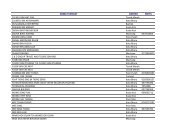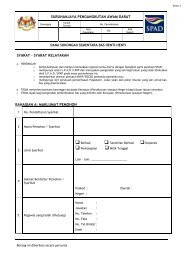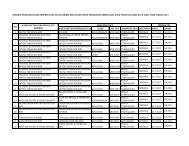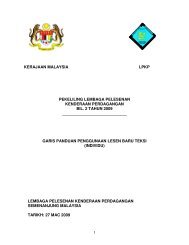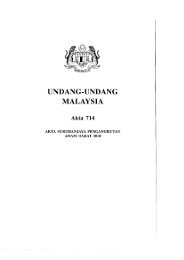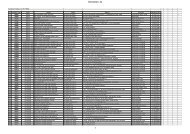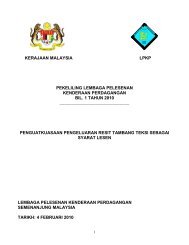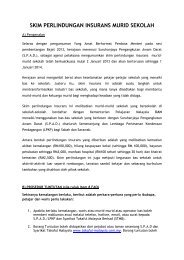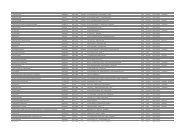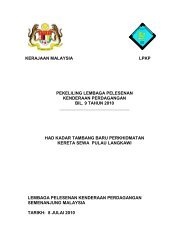4. Developing the Taxi Transformation Plan - SPAD
4. Developing the Taxi Transformation Plan - SPAD
4. Developing the Taxi Transformation Plan - SPAD
You also want an ePaper? Increase the reach of your titles
YUMPU automatically turns print PDFs into web optimized ePapers that Google loves.
2.9) <strong>Taxi</strong> Stand and Telephone Bookings<br />
<strong>Taxi</strong> stands are located across <strong>the</strong> region but <strong>the</strong>re is no central database of information specifying<br />
where stands are located, or <strong>the</strong>ir capacity and operational times. Coverage across GKL/KVs<br />
inconsistent as stands provided in key locations such as major terminals, <strong>the</strong> main tourist locations<br />
and major shopping centres <strong>the</strong>y are operated in different ways which can cause some confusion<br />
and reluctance amongst <strong>the</strong> drivers and public to use taxi stands. Many drivers do not operate from<br />
taxi stands at all and simply circulate plying for hire on <strong>the</strong> street. <strong>Taxi</strong>s Stands can be operated in<br />
<strong>the</strong> following ways:<br />
<br />
<br />
<br />
<br />
Voucher prepay system – fare is prepaid at a booth based on <strong>the</strong> stated destination and <strong>the</strong><br />
voucher presented to <strong>the</strong> driver who does not <strong>the</strong>n use <strong>the</strong> meter. Typically vouchers are RM<br />
2 to RM 4 more expensive than <strong>the</strong> metered fare and this surcharge pays for <strong>the</strong><br />
administration of <strong>the</strong> scheme and <strong>the</strong> marshals‟ who direct passengers to taxis. (For<br />
example: KL Sentral)<br />
Manned taxi stand – RM2 surcharge is paid in cash to <strong>the</strong> administrator on <strong>the</strong> taxi stand who<br />
directs passengers to cabs. <strong>Taxi</strong> driver <strong>the</strong>n operates <strong>the</strong> meter and <strong>the</strong> fare is payable as<br />
usual. (Example: KLCC)<br />
Unmanned or manned - taxi charged by <strong>the</strong> meter and no surcharge payable.(Example<br />
outlying shopping centre ranks)<br />
Informal taxi stands - queues of taxis on <strong>the</strong> road where no taxi stand appears to exist but<br />
drivers believe <strong>the</strong>re is a demand.<br />
The operators of some taxi stands charge drivers to ply at particular stands. For example, it is<br />
understood drivers must pay RM 100 per month in order to obtain a badge allowing <strong>the</strong>m to ply for<br />
hire at KL Sentral.<br />
Although most passengers obtain <strong>the</strong>ir taxi by walking outside to a taxi stand or flagging a vehicle<br />
in <strong>the</strong> street as it passes, taxis may also be booked by telephone. There are a number of telephone<br />
operations across GKL/KV. However it is understood from public comments that telephone booking<br />
is perceived to be unreliable and so not <strong>the</strong> preferred method of hire. The majority of <strong>the</strong> taxi<br />
fleet do not operate with radio circuits and are <strong>the</strong>refore unable to be dispatched to a telephone<br />
booking easily. There is an initiative among 17 taxi operators to equip <strong>the</strong>ir fleet with radios in <strong>the</strong><br />
GKL/KV region.<br />
Although operators take telephone bookings <strong>the</strong>y estimate <strong>the</strong> percentage of calls not met is up to<br />
60%. Anecdotally it is understood drivers will not accept bookings unless <strong>the</strong>y are in <strong>the</strong> immediate<br />
area or <strong>the</strong>y would be out of pocket travelling to <strong>the</strong> fare – even allowing for <strong>the</strong> RM3 surcharge.<br />
2.10) Current <strong>Taxi</strong> Operating Costs and Revenues<br />
A review of taxi operating costs has been carried out for <strong>the</strong> LPTMP. Operating costs will vary from<br />
driver to driver and vehicle to vehicle depending on <strong>the</strong>ir driving style, how <strong>the</strong> taxi is operated<br />
and how it is maintained. This review relates to an average case. The variable and fixed costs<br />
associated with ei<strong>the</strong>r purchasing a vehicle over a five year period or leasing a vehicle from a<br />
company operator have been established along with <strong>the</strong> estimated maintenance costs associated<br />
with carrying out <strong>the</strong> manufacturers recommended maintenance schedule. The costs allow for<br />
labour, parts and insurance. Based on feedback from taxi operators relating to daily kilometres<br />
travelled an estimated cost of fuel has also been established. Toge<strong>the</strong>r <strong>the</strong> figures set out average<br />
monthly outgoings. The figures exclude extra optional outgoings such as <strong>the</strong> payment of fees to ply<br />
at particular locations such as KL Sentral.<br />
Page 19


